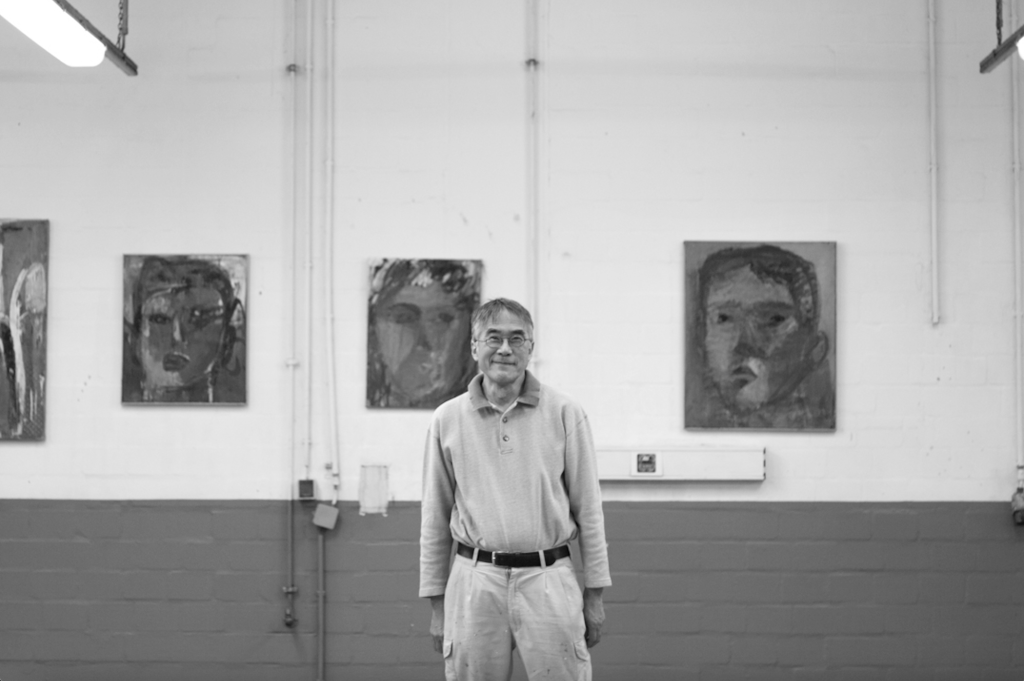Masao Nakahara (1956, JP)
Participating in the exhibition “tomodachi to – Mit Freund*innen” at Kunsthalle Düsseldorf (DE) in 2021 upon invitation of his long time friend Yoshitomo Nara, shed a new light on the art practice of Nakahara, who paused his art career from the mid-nineties until 2015 to take care of his family. This exhibition introduced the gallery to his practice, and started a collaboration from that moment onwards.
From his academy years up until now, Nakahara’s works symbolize little monuments of thoughts, that depict figures with embryo-like yet ageless heads, often on the move between life and death. Momento Mori, or landscapes that represent the passing of life, referencing Japanese culture and mythologies. This transition between our physical world and the afterlife has fascinated the artist since his childhood, and has become a ‘leitmotif’ throughout his career, resulting in a form of estranged yet friendly visual poetry.
“When I was little, I was afraid of dying…I wondered what would happen after I died, and if everything would end when I did”…”When I was 10 years old a thought came to me. Whenever I was in that room at that time of the day, the sun was shining brightly, and I felt happy. And in that moment, I thought that light would always be shining in this room at that time of the day and would continue to do so, even if I died. …”and I thought “that’s fine then”.
Nakahara grew up in a small town in Japan (Honjō, Saitama Prefecture), and started painting from a very early age. His introduction to artists such as Fauvist Georges Rouault and Impressionist Maurice Utrillo, opened up new perspectives for an artist that was rather interested in visualizing his own introspective world, than wanting to adapt to the prevailing morality of Tokyo’s art schools.
In the early 1980’s Nakahara came to Germany, where he studied at the Dusseldorf Art Academy between ’83 and ’88. Here his art practice got influenced by the expressionist movement of the Neue Wilden, resulting in portraits like ‘The Headman’ (1984), ‘Table’ (1985-87) and ‘The Two’ (1988). The portraits helped the artist “..to hold on to something, whenever I did not know what to do, or when I felt lonely or troubled.”
These early paintings, more precisely present within the early sculptures, reveal the artist’s incipient desire to refer to the beginning of things expressed through the embryo-like yet ageless figures, as he stated; “To die one must be born first”.
From the 1990’s onwards Nakahara introduces a broader iconography to his practice, which mark a thoughtfulness and pathos that seemed to reflect more in dept on themes such as impermanence, temporality, and beauty. Often metaphorically characterized by (Cherry blossom) trees, boats, bridges, and infinite paths, finding their origins in Japanese myths on death.
Edgard Munch comes to mind when looking at the landscape as a metaphor for death, but more directly Nakahara’s work has been influenced by a work of Sekine Shōji entitled “Mourning Believers” (1918), that deals with a bridge linking life to death. Shōji was a Japanese painter, that died when he was only 20 years old, and left a remarkable oeuvre.
In this context Nakahara’s modest and introspective visual language can be read as an ode to the beauty of the simple things that characterize life. Small puzzles that invite personal introspection and reduce life’s big questions to manageable fate.

1956 born in Saitama, Japan
Education
1978–80 Nihon Art School in Tokyo
1982–83 Braunschweig University of Fine Arts
1983–88 Duesseldorf Art Academy
Solo exhibitions
2022
Daydreams and Memories, Althuis Hofland Fine Arts, Amsterdam, The Netherlands (solo)
Youth, Group exhibition with Yoshitomo Nara, YKG Gallery, Tokyo, Japan
»tomodachito« »Mit Freund*innen«, Group Exh. (Takeoka Yūji, Nara Yoshitomo, Murase Kyōko, Andō Yukako, Kinoshita Ryō, Anca Muresan, Karin Sander, Arakawa Soya and Magdalena Jetelová), Kunsthalle Duesseldorf (D)
5 Japanische Künstler aus Düsseldorf, Group Exh. (Motoko Aoki, Ai Hagita, O-Jun and Sumiko Naganuma), Kunstraum Neuss, Germany
Zeitgenössische Kunst aus Japan with Yoshio Yoshida, Stadtsparkasse Neuss, Gallery Sels in Neuss, Germany
KIKKOO 6 Japanese artists from Duesseldorf, (Ai Hagita, Setsuko Ikai, Nobuko Sugai, Takeshi Suzuki and Hiroshi Teshima), Eller / Duesseldorf (D)
De Reizende Zon, 6 Japanese artists (Ai Hagita, Setsuko Ikai, Nobuko Sugai, Takeshi Suzuki and Hiroshi Teshima), Kunsthal Almelo, The Netherlands
Exhibition with Petr Vrána in Exhibitionsforum of GHK (Studio Kausch) Kassel, Germany
Exhibition with Manne Sens in Westermann publishing house in Braunschweig, Germany
1982
Landschaft und Metapher, Group exhibition of the art department of the University Kassel